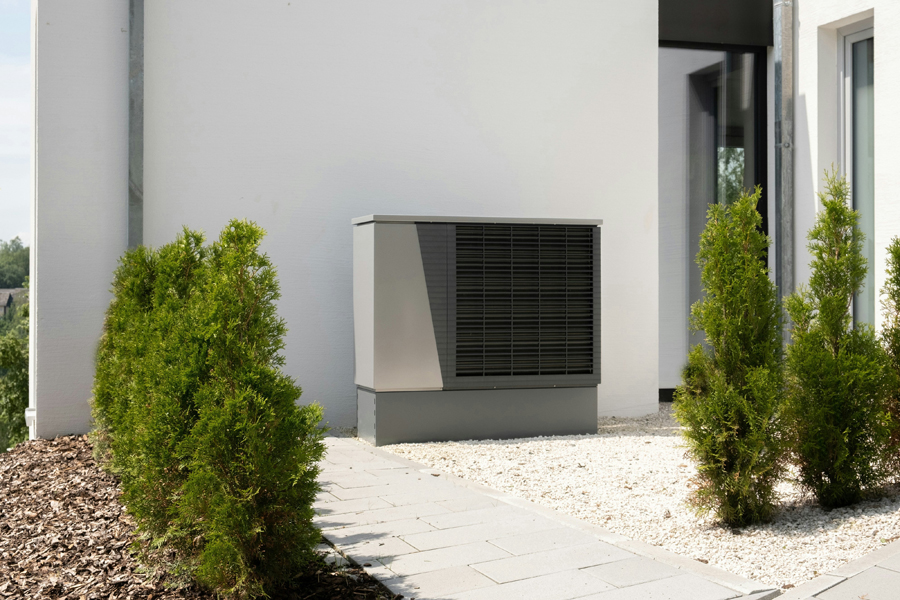Rebecca Hogg, Technical Manager at BSRIA, discusses how the growing demand for heat pump installations is driving a need for specifiers to take a broader, more holistic, view of system design.
The sharp rise in heat pump adoption is placing new demands on designers, requiring a more integrated approach to system specification and building design.
In 2024, the UK heat pump sector reached a new milestone, with nearly 110,000 units sold, representing a 48% increase on the previous year and the highest figure on record[1]. Around half of these installations went into replacement projects, with retrofit applications continuing to grow steadily.
While this growth highlights a pivotal stage in the low-carbon transition, any mismatch between design and operational reality could leave systems with a performance gap, meaning that the heat pump system could under-deliver, and occupants may face running costs that are higher than forecasted. This places pressure on the electrical grid, increasing the responsibility for designers to ensure that the systems specified will perform in line with design intent.
The challenge is that the UK’s diverse building stock makes heat pump system design far from one‑size‑fits‑all. Instead, every project demands a bespoke solution.

Drivers of growth
Several factors underpin the ongoing acceleration of heat pump installations. One of the most significant factors has been the relaxation of planning rules through changes to Permitted Development Rights (PDR) earlier this year.
The key updates included increasing the maximum allowable unit size from 0.6m³ to 1.5m³, enabling the use of more varied designs, and the addition of features such as acoustic insulation or alternative fan technologies. Meanwhile, the removal of the previous one-metre boundary restriction means that planning permission is no longer necessary for heat pumps installed on houses close to neighbouring properties, such as terraced houses. This is a particularly significant change when considering that terraced homes account for 24–31%[2] of the housing stock in England and Wales.
Alongside regulatory progress, public awareness has grown rapidly, driven in large part by national media attention and industry campaigns, especially from major utility providers. This campaigning means that heat pumps are increasingly recognised not only as an environmentally sound choice, yet also as an economically attractive alternative to fossil fuel heating systems. At the same time, financial support such as the Boiler Upgrade Scheme, which offers grants of up to £7,500 for heat pump installation, has further driven the acceleration of retrofit activity.

Taking a holistic view
The versatility of heat pump applications provides greater scope for use across a range of low carbon solutions whether this be space heating, cooling or domestic hot water production. However, while the increasing momentum behind heat pump adoption signals progress in the wider drive for decarbonisation, challenges exist for designers.
For those specifying or designing heat pumps systems, accurately quantifying a building’s baseline performance is essential to ensuring correct system sizing and achieving optimal system performance. The outputs from rapid building performance measurement techniques will also influence the sizing of the heat sink, whether this be an underfloor heating system or panel radiators.
But in addition to considering the requirements of the heat pump itself, to ensure that the system will perform effectively, specifiers need a holistic understanding of the building’s fabric and energy profile.
In recent years, reliance has been placed on Energy Performance Certificates (EPCs). However, EPCs are primarily assumption-based rather than being founded on physical testing of the building fabric. This means that they fall short of providing the level of accuracy required for effective heat pump specification.
Instead, more detailed building performance assessments should be carried out, including evaluations of airtightness, thermal bridging, U-values and overall envelope characteristics. This kind of diagnostic insight provides a far clearer picture of how a heat pump will perform once operational.
Only when the whole-building context is fully understood can designers confidently specify systems that will achieve both occupant comfort, efficiency, and reliability.

Performance in practice
Comprehensive verification is just as important on the product side. Heat pump manufacturers should provide credible energy labels supported by documentation detailing performance metrics based on robust testing.
To ensure that a heat pump will work within a specific application, designers and specifiers should request full test reports from accredited testing laboratories. These are crucial to provide assurance that a heat pump will perform as intended because they detail how performance is measured, under what conditions, and confirm compliance with standards such as EN 14511 and EN 14825 for thermal performance, and EN 12102 for acoustic testing.
For specifiers, it’s also important to look out for independent laboratory testing, such as that provided by UKAS-accredited bodies. These ensure the highest standards of testing and provide confidence in product claims to ensure that the heat pump specified will meet any specific performance criteria, and scheme requirements.
But beyond technical specification, it’s important to note that even the most well-designed systems depend on user engagement. Unlike traditional gas boilers, heat pumps operate with longer running cycles and variable heating outputs which means that they require a behavioural shift in how indoor temperature is managed. This means educating end-users is vital to maximising performance and satisfaction.
A net-zero building also requires net-zero behaviour. So, integrating user education and clear guidance into the design and handover process is fundamental in supporting a successful transition. By doing so, we can help to encourage further uptake by simultaneously framing energy savings as the primary incentive, with decarbonisation as a valuable byproduct.
Bridging design and reality
Ultimately, success depends on applying a holistic mindset.
In new-build environments, any gap between design intent and as-built performance can limit the operational performance of heat pumps, eroding both efficiency and comfort. Retrofit applications pose their own challenges, with existing fabric conditions needing careful diagnostic assessment to avoid performance shortfalls.
Overall, though, the advancements made so far have been significant, presenting a real opportunity to reduce the UK’s dependence on fossil fuels.
And the solutions to ensure success are already available. By combining evidence-based specification, rigorous building diagnostics, verified product testing, and effective occupant education, designers will play a central role in shaping systems that not only perform as intended and deliver comfort for residents, but also advance the UK in its drive towards decarbonisation.
[1] BSRIA, Market Intelligence for the World Heat Pump Market 2025
[2] Gov.uk, Official Statistics, Council Tax: stock of properties statistical commentary, 2024












